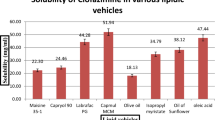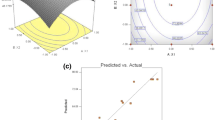Abstract
The aim of this study was to systematically obtain a model of factors that would yield an optimized self-nanoemulsified capsule dosage form (SNCDF) of a highly lipophilic model compound, Coenzyme Q10 (CoQ). Independent variables such as amount of R-(+)-limonene (X 1), surfactant (X 2), and cosurfactant (X 3), were optimized using a 3-factor, 3-level Box-Behnken statistical design. The dependent variables selected were cumulative percentage of drug released after 5 minutes (Y 1) with constraints on drug release in 15 minutes (Y 2), turbidity (Y 3), particle size (Y 4), and zeta potential (Y 5). A mathematical relationship obtained,Y 1=78.503+6.058X 1 +13.738X 2+5.986X 3−25.831X 21 +9.12X 1X2−26.03X 1X3−38.67X 22 +11.02X 2X3−15.55X 33 (r 2=0.97), explained the main and quadratic effects, and the interaction of factors that affected the drug release. Response surface methodology (RSM) predicted the levels of factorsX 1,X 2, andX 3 (0.0344, 0.216, and 0.240, respectively), for a maximized response ofY 1 with constraints of >90% release onY 2. The observed and predicted values ofY 1 were in close agreement. In conclusion, the Box-Behnken experimental design allowed us to obtain SNCDF with rapid (>90%) drug release within 5 minutes with desirable properties of low turbidity and particle size.
Similar content being viewed by others
References
Nazzal S, Khan MA. Response surface methodology for the optimization of ubiquinone self-nanoemulsified drug delivery system.AAPS PharmSciTech. 2002;3 (1):E3.
Nazzal S, Zaghloul AA, Reddy IK, Khan MA. Analysis of ubidecarenone (CoQ10) aqueous samples using reversed phase liquid chromatography.Pharmazie. 2001;56:394–396.
Pouton CW. Lipid formulations for oral administration of drugs: non-emulsifying, self-emulsifying and self-microemulsifying drug delivery systems.Eur J Pharm Sci. 2000;11(suppl 2):S93-S98.
Charman SA, Charman WN, Rogge MC, Wilson TD, Dutko FJ, Pouton CW. Self-emulsifying drug delivery systems: formulation and biopharmaceutic evaluation of an investigational lipophilic compound.Pharm Res. 1992;9:87–93.
Li S, Lin S, Chien YW, Daggy BP, Mirchandani HL. Statistical optimization of gastric floating system for oral controlled delivery of calcium.AAPS PharmSciTech. 2001;2(1):E1.
Chopra RK, Goldman R, Sinatra ST, Bhagavan HN. Relative bioavailability of coenzyme Q10 formulations in human subjects.Int J Vitam Nutr Res. 1998;68:109–113.
Sastry SV, Khan MA. Aqueous based polymeric dispersion: Plackett-Burman design for screening of formulation variables of atenolol gastrointestinal therapeutic system.Pharm Acta Helv. 1998;73:105–112.
Korakianiti ES, Rekkas DM, Dallas PP, Choulis NH. Optimization of the pelletization process in a fluid-bed rotor granulator using experimental design.AAPS PharmSciTech. 2000;1(4):E35.
Abu-Izza K, Garcia-Contreras L, Lu DR. Preparation and evaluation of zidovudine-loaded sustained-release microspheres. 2. Optimization of multiple response variables.J Pharm Sci. 1996;85:572–576.
Hamed E, Sakr A. Application of multiple response optimization technique to extended release formulations design.J Control Release. 2001;73:329–338.
Boza A, De la Cruz Y, Jordan G, Jauregui-Haza U, Aleman A, Caraballo I. Statistical optimization of a sustained-release matrix tablet of lobenzarit disodium.Drug Dev Ind Pharm. 2000;26:1303–1307.
Box GEP, Wilson KB. On the experimental attainment of optimum multifactorial conditions.Royal Statistics Society. 1951;13:1–12.
Singh SK, Dodge J, Durrani MJ, Khan MA. Optimization and characterization of controlled release pellets coated with experimental latex: I. Anionic drug.Int J Pharm. 1995;125:243–255.
Sanchez-Lafuente C, Furlanetto S, Fernandez-Arevalo M, et al. Didanosine extended-release matrix tablets: optimization of formulation variables using statistical experimental design.Int J Pharm. 2002;237:107–118.
Ragonese R, Macka M, Hughes J, Petocz P. The use of the Box-Behnken experimental design in the optimisation and robustness testing of a capillary electrophoresis method for the analysis of ethambutol hydrochloride in a pharmaceutical formulation.J Pharm Biomed Anal. 2002;27:995–1007.
Box GEP, Behnken DW. Some new three level designs for the study of quantitative variables.Technometrics. 1960;2:455–475.
Craig DQM, Barker SA, Banning D, Booth SW. An investigation into the mechanism of self-emulsification using particle size analysis and low frequency dielectric spectroscopy.Int J Pharm. 1995;114:103–110.
Khan MA, Dib J, Reddy IK. Statistical optimization of Ketoprofen-Eudragit S100 coprecipitates to obtain controlled-release tablets.Drug Dev Ind Pharm. 1996;22:135–141.
Box GEP, Hunter WG, Hunter JS.Statistics for Experimenters: An Introduction to Design, Data Analysis, and Model Building. New York, NY: John Wiley & Sons; 1976.
Leiberman HA, Reiger MM, Banker GS.Pharmaceutical Dosage Forms: Disperse Systems. Vol 2. New York, NY: Mercel Dekker, 1989.
Author information
Authors and Affiliations
Corresponding author
Rights and permissions
About this article
Cite this article
Palamakula, A., Nutan, M.T.H. & Khan, M.A. Response surface methodology for optimization and characterization of limonene-based coenzyme Q10 self-nanoemulsified capsule dosage form. AAPS PharmSciTech 5, 66 (2004). https://doi.org/10.1208/pt050466
Received:
Accepted:
DOI: https://doi.org/10.1208/pt050466




